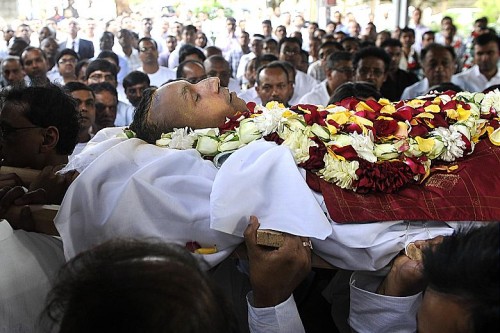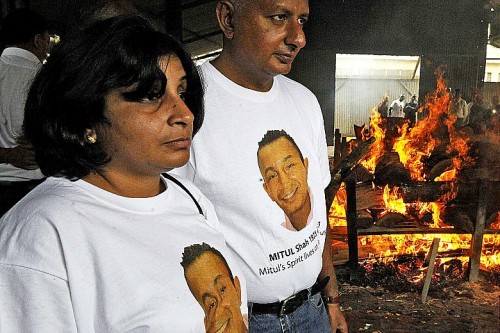The funeral of Mitul Shah
We bear mortality by bearing mortals — the living and the dead — to the brink of a uniquely changed reality: Heaven or Valhalla or Whatever Is Next. We commit and commend them into the nothingness or somethingness, into the presence of God or God’s absence. Whatever afterlife there is or isn’t, human beings have marked their ceasing to be by going the distance with their dead — to the tomb or the fire or the grave, the holy tree or deep sea, whatever sacred space of oblivion we consign them to. And we’ve been doing this since the beginning.
The formula for our funerals was fairly simple for most of our history: by getting the dead where they needed to go, the living got where they needed to be.
Ours is the species that deals with death (the idea of the thing) by dealing with our dead (the physical fact of the thing itself).
The presence of the dead is an essential, definitive element of a funeral.
These four essential, definitive elements, then: the corpse, the caring survivors, some brokered change of status between them, and the disposition of the dead make a human funeral what it is.
Stements extracted from an essay by Thomas Lynch here.
If Mr Lynch is right, how much more essential and elemental to bring the dead to their funeral for all to see and mourn, as in the photo above of of Mitul Shah, killed by terrorists in the Westgate mall in Kenya.
The cremation of Mitul Shah




It does indeed seem vitally important to have the decedent present at the funeral. The human body is so inextricably associated with the human person that it’s hard to think of a human person apart from his or her body. Images from this Sikh funeral for a young father, murdered by al-Qaeda-linked Islamist terrorist group Al-Shabaab, form a poignant reminder of this.
It’s a moving image, this dead man – too soon to call him a dead body – covered in flowers, surrounded by living people here to witness his body minus his spirit and do the arithmetic, before watching the disposal with their own eyes instead of imagining him in his coffin and being presented later with the cremevidence.
Both the very evident presence and absence of the dead are essential, or what’s a funeral about?
An interesting and thought provoking post Charles, as ever.
Out of interest, do you agree with Mr Lynch regarding the four essential, definitive elements he suggests?
An increasing number of people seem to not feel the need to be present at the point of committal. Predominantly I’ve noticed this with cremation services as opposed to burial, which I believe relates to the finality of the resting place and most families wanting to be involved with that (families can of course be given the ashes and hold their own ceremony at another time, whereas with burial the interment is the final place of rest meaning a majority want to witness this).
Defining what a funeral is (beyond dictionary definition) lies in the eyes of the beholder I think.
I assume by committal at a cremation funeral you mean committal to the flames. Have I got that right, Hazel? Lynch believes it should be witnessed, and attends the committal of all crematees handled by his funeral home whether family members are present or not. In Britain hardly anyone witnesses, do they?
Which is why Lynch says that people nowadays like to have their dead ‘disappeared’. If you believe in ‘going the distance’, as Lynch puts it, then that’s a fair verb, I suppose. But I think people are increasingly agreeing on a vanishing point (curtains is a good example) — which is why crematoria can get away with up to 72 hours’ holding over. This is a significant psychological shift.
I think Lynch is wrong. Cremation does not necessarily ‘disappear’ someone, and for many renders the corpse suitable for a rite of secondary treatment — an ashes ceremony. Where people do not want their dead ‘disappeared’ by cremation, then the ritual of committal at the crematorium would seem to be in need of re-thinking. It would seem to me to be entirely anomalous.
I agree, a funeral is what people think it is, but I do not know that most have brought their ideas into sharp focus. I say ideas, but I guess most people work from intuition. For those who feel that the corpse should be present at the funeral, I do feel that the matter of whether or not the corpse should be hidden in a box is something they need to think through.
If a good many good people feel that, when the death happens, they have said what they need to say and done what they need to do, then a conventional funeral is just so much unnecessary palaver — the vanishing point has already occurred. To talk of them wanting their dead to be ‘disappeared’ as if they were being somehow denialist would seem to me to be harsh and mistaken.
The puzzle around “committal” at a crematorium ceremony, where the body goes into the flames unwitnessed, but family may later commit the ashes to the woods, the ocean or a cemetery, is a real one. I seem to have stopped using the word “committal” in the ceremony and on any leaflets; “words of farewell” seems better to me, if words are used.
I think that’s a good call, GM. Most people agree the decedent should be present at the funeral, and, for burial, most are present at the committal to the ground, too. For cremation, I don’t have a strong view about witnessing the incineration just as I don’t have a strong view about the coffin being open or closed at the funeral. It’s down to choice. However, I do think people need to be reminded that the committal is not the closing of the curtains or the cremation itself, but the delivering of the cremains to their final resting place, whether buried or throw to the wind.
Richard, ‘decedent’ is a ghastly American euphemism — so ghastly it has been shunned even by our native undertakers. They prefer ‘deceased’ (pl ‘deceaseds’), which is arguably little better. Here at the GFG-Batesville Shard we prefer ‘corpse’ or ‘dead person’. We concede your right to use ‘decedent’ but, please note, would not be prepared to defend it to the death.
Our dim view extends also to ‘cremains’.
Perchance you think we harrumph too much?
I stand corrected, Charles. Don’t know what got into me to use words like decedent and cremains. I think I prefer cadaver and slag.
Actually, out of respect for our American readers, I wish I hadn’t written that. Please say it as you see it, Richard. (It may have been discourteous to you, too, which I would regret.)
Back to words. The more significant the act the more euphemisms to describe it. Take, for example, sex (making love, hanky panky, rumpy pumpy, shagging) or getting drunk (merry, tipsy, squiffy, sozzled, pissed, rat-arsed).
Death has more than its fair share of words: asleep, no more, taken from us, departed, deceased, demised, expired, resting in peace, pushing up the daisies, gone to meet their maker, stiff, in a better place, six feet under, checked out, given up the ghost, become living-challenged…
While some terms seem overly coy (passed away), others seem unsympathetic (snuffed it).
Rather than namecall them euphemisms (evasive), perhaps we should see them as adding meaning and specificity. ‘Passed’ connotes transition, mystery and continuing consciousness, whereas ‘snuffed it’ connotes extinction. ‘Resting in peace’ is suffused with dormancy whereas ‘pushing up daisies’ speaks of an active death-state. In the same way, ‘shagging’ has overtones of brutishness in contrast to ‘making love’, which speaks of something altogether gentler and more Tantric.
Still doesn’t reconcile me to ‘decedent’, though — but then ‘decedent’ is not a mot-juste euphemism, it’s jargon.